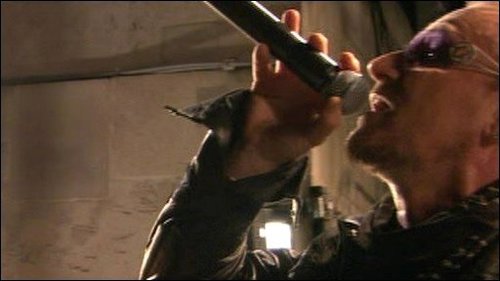
‘About ten minutes before it started, I received a text from my cousin Mark who said Rolling Stone had called this song U2’s tribute to Mandela. So no pressure then!‘
The song Ordinary Love, written for ‘Mandela: Long Walk To Freedom’, is accompanied by a striking lyric video in which the handwritten words to the song fade and degrade and vanish.
This unusual approach was created by two visual artists, Irish illustrator Oliver Jeffers and American animator and collagist Mac Premo. The pair, who work out of an artistic hub in Brooklyn, have been friends since meeting in a summer camp in upstate New York as teenagers. Just now, they’re skyping Stuart Bailie for U2.com from Oliver’s studio, and remembering how they came to approach Ordinary Love. At the centre of the song is the story of Nelson Mandela and his 27 years imprisonment in South Africa.
U2.com: Can you explain the idea behind the words disappearing?
Oliver: It’s about the difficulty of permanent love. The correspondence between Nelson Mandela and Winnie (his then wife) worked so well within confinement but when he was released, the real world took its toll and made it go away. So it was about the lack of anything permanent, really. It’s disheartening, but it’s also heartening to a degree, where it inspires you to hurry up a little bit.
Mac: The idea of the writing fading is that when things go away, it’s often not a clean break. They fade away in different forms and different manners, different ways. It’s not a clean process. You don’t know how its exactly happening but you can see that it is. I think Oliver and I both responded to the song in that it didn’t look to sugarcoat a real moment for a very epic man. The opportunity to portray that human element of someone so grand is pretty humbling. We wanted to do the best work to represent that.
U2.Com: How did the commission come about?
Oliver: I’d met Bono through a mutual connection a couple of times and been talking about my work. Then when I was asked to do the typography for a TED film, I saw that Bono’s name was down as one of the TED speakers (‘The Good News on Poverty’). I thought, ‘We’re gonna be there, he’s gonna be there, I’ll send him send him one of my art books.’ So I did.
He got in touch with the idea of having me doing the visuals for his talk – which ended up not working – but the conversation was sufficiently interesting that he asked me to be part of this workshop he was giving at TED. Mac and I both went to it, fell in love with the ONE Foundation and as a result were invited to make a film for ONE, which we asked Bono to do the voiceover for.
After seeing it, Bono asked if I was available to do a lyric video for ‘Ordinary Love’ (and) that grew into a conversation through Studio AKA (the London animation studio that worked on the adaption of Oliver’s ‘Lost and Found’ book). The original intention had been to animate words that just disappear but when Mac and I started working again on this we thought rather than have CGI aspects of making the writing go away that there was a way to let it all happen in camera.
Mac: This quickly became the kind of thing that was less about computer graphics and more about an artistic exploration in camera, a handmade thing. And that’s really a lot of the work we’ve done. With a lot of the things that get done with Oliver and I, there’s a lot of discovery in the process. The process informs the product.
Oliver: ‘It’s definitely a reaction against how slick everything is becoming. There’s a nice bounceback from that. Everything you see in our films is what the camera sees. Apart from one very obvious place.
U2.Com: In the video, is there a real or imagined connection to one of the prisons that Mandela was held in?
Oliver: ‘We were aware what the song was inspired by and then we found that it was going to be tied in with the movie, ‘Mandela: Long Walk To Freedom’.
Mac: We watched the trailer and there’s a sense to the colours and the textures that plays into our handmade process. But as the film developed, there was a collective decision to try and incorporate the two, to mesh the Mandela film and the lyric video. So we started to glean ideas from the film.
Oliver: There’s the scene in the video with the freight elevator and the cage above, we definitely turned those up after the first round of revisions because it spoke more of the cell that he was held captive in for so long. Most of this was shot in the Invisible Dog building where Mac and I both have studios. There’s one scene that’s shot in Prospect Park. Everything else, like the side of the walls and where you see sky, is all shot on the roof of this building.
Mac: The Invisible Dog Arts Centre is in Brooklyn and the director is a man named Lucien Zayan. He really wants to foster creative environments so when we went to him and asked, can we basically write all over your building in chalk and paint, he said ‘Yes’. Which is still shocking! It’s a beautiful 100-year-old building and when Lucien turned it into an arts centre he didn’t do a ton of hiding or restoration of the way it has looked for a long time. So there’s a lot of character and visual history in the place, a lot of beautiful aspects to the building. It was a pleasure to use it as a canvas.
U2.Com: Oliver, there’s a Mandela portrait in the video. Was that a high pressure moment, trying to paint an icon?
Oliver: My God that was. One of the last minute decisions was to make the link much more directly obvious, to have the image of Nelson Mandela in there. To be honest, Mac and I had pushed back against that. We couldn’t see how it would fit in and so the band got together on speakerphone and phoned me over Sunday breakfast. They took about ten minutes to explain why it was so important, their connection with the man and the film. That made a lot of sense to me and so Mac and I got together and brainstormed.
The overarching idea is that everything is created and everything is taken away. All the words are made visual and then they’re erased in some way. But to have that happen to Mandela seemed somehow disrespectful. So we had the idea that the sun comes up at the start of the film then we come back to it and see the portrait being created in time lapse and then at the close of the film it’s the sun setting. That felt much more respectful.
So everyone was on board with that and then it came time for the time lapse of the portrait actually being created and I thought, ‘Oh yeah, now I have to paint a portrait of Mandela’. About ten minutes before it started, I received a text from my cousin Mark who said Rolling Stone had called this song U2’s tribute to Mandela. So no pressure then!
Mac: We showed up on the roof at around a quarter to six to get the sunrise coming up. The funny thing was that the sun had to come over the bulkhead of the roof where we filmed it. I have to say there was a brotherly pleasure in having to wait four hours into our work day watching Oliver squirm before he started this time lapse portrait. We wanted to shoot as the whole day transpired. He didn’t have anything that you could do beforehand and then place it in. He didn’t have an hour or two to make this happen. Given the time lapse nature of the film, there was a fair amount of pressure.

U2.COM: There’s also an image of Bono in the video.
Oliver: When we were putting this together we realized that ‘fight you’ fits perfectly across the eight knuckles. We thought if we’re gonna have knuckles and a face, let it be one of the band’s. So we asked him and he said, ‘Come on over’. So Mac and I went over.
Mac: It was in a windowless office at around 11 o’ clock at night with a halogen light. Literally a catch-as-catch-can moment, at Electric Lady Studios.
U2.Com: Was there a moment you sat in a room and let the band watch it, or did you just send it off?
Mac: There were lots of incarnations of the video. The first thing was that we storyboarded out the whole thing and came up with all these ideas and the different scenes that worked metaphorically. And then after the first shoot days and looking at the edit we all agreed that it had to see its time out in cameras, rather than digitally.
We shuffled everything, added shoot days, went back, built other stuff and then everything got thrown back into the blender creatively. So we would send different incarnations and get feedback. There was a fair amount of creative collaboration going back and forth. And at a certain point we sent them one version and said, ‘There it is. That’s the final one.’ And they came back and said ‘Yes, that’s great.’”







